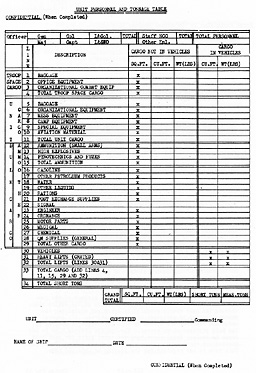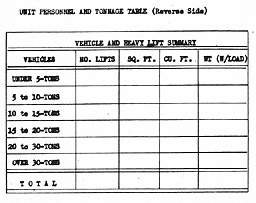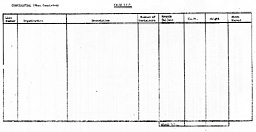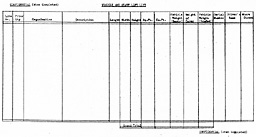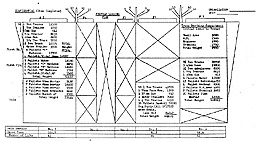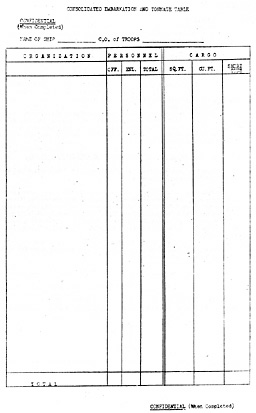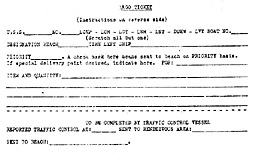Line #16 -- GASOLINE -- includes the cubic feet and weight of all
gasoline, either in cans or drums.
Line #17 -- OTHER PETROLEUM PRODUCTS -- includes the cubic feet and
weight of diesel fuel, lubricating oils, greases, etc., either in
cans or drums.
Line #18 -- WATER -- includes the cubic feet and weight of all water,
either in cans or drums.
Line #19 -- OTHER LIQUIDS -- includes the cubic feet and weight of
all other liquids, including acids, paint, alcohol, chemical warfare
liquids, etc.
Line #20 -- RATIONS -- includes the cubic feet and weight of all types
of rations, including rations for initial issue to troops prior to debarkation.
Line #21 -- PX SUPPLIES -- includes the cubic feet and weight of all
commissary, post exchange, fleet canteen stocks, ships' stores, etc.
Line #22 -- SIGNAL -- includes all signal Classes II and IV maintenance
supply and equipment. Such items include telephones, radios, searchlights,
blinkers, sound systems, spare parts, etc.
Line #23 -- ENGINEER EQUIPMENT -- includes all engineer Classes II and
IV maintenance supply and equipment. Such items include compasses,
drafting and duplicating equipment, camouflage nets, garnishing rolls,
sketching equipment, etc.
Line #24 -- ORDNANCE -- includes the cubic feet and weight of all
ordnance Classes II and IV maintenance supply and equipment, such as
spare parts for all weapons.
Line #25 -- MOTOR PARTS -- includes the cubic feet and weight of all
motor parts Classes II and IV maintenance supply and equipment, such
as spare parts for all motors, trucks, boats, etc.
Line #26 -- MEDICAL -- includes the cubic feet and weight of all medical
Classes II and IV maintenance supply and equipment, such as additional
Thomas splints, bandages, tapes, stretchers, portable operating
tables, etc. (excluding liquid chemicals which are listed under line
#19). This line is for maintenance or resupply medical equipment supplied
by higher echelons. (Medical supplies, less liquid chemicals,
for the landing team medical section will be shown on line #6).
Line #27 -- CHEMICAL -- includes the cubic feet and weight of all dry
chemical warfare Classes II and IV maintenance supply and equipment,

